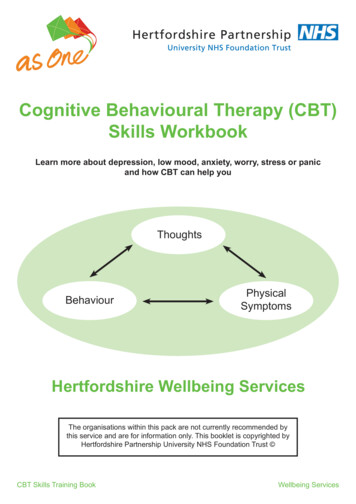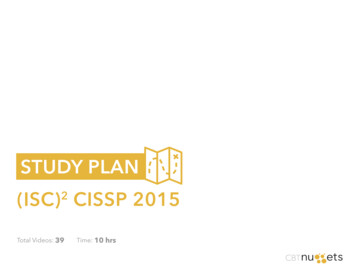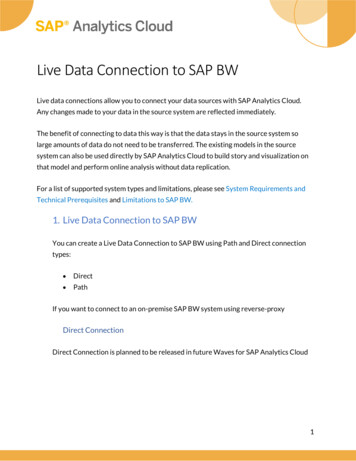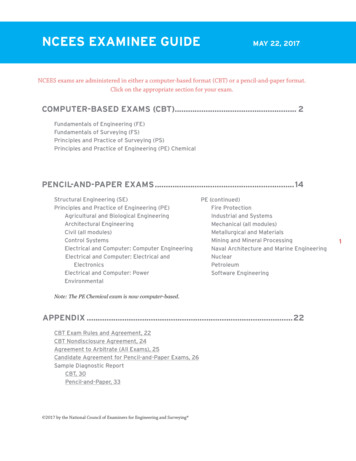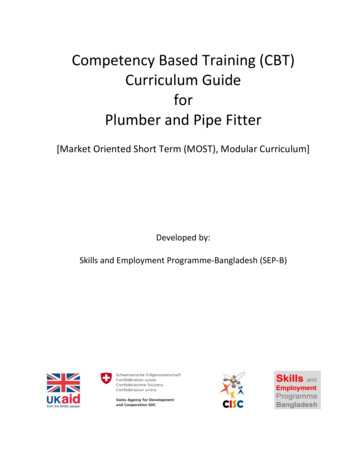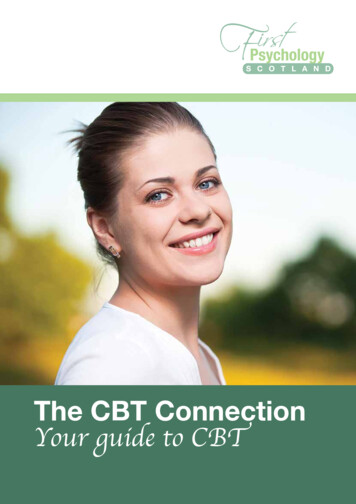
Transcription
The CBT ConnectionYour guide to CBT
An introduction to cognitivebehaviour therapy (CBT)Cognitive behaviour therapy (also known ascognitive behavioural therapy) is a form ofpsychotherapy that has, through scientificresearch, been proven to help with a numberof problems, such as stress, low self-esteem,anger, phobias, and is recommended in theguidelines of the National Institute for Healthand Clinical Excellence (NICE) for treatmentof depression, anxiety, eating disorders,insomnia, self-harm, obsessive compulsivedisorder, and post-traumatic stress disorderas well as schizophrenia, among otherthings. Aside from medication, CBT is thenumber one treatment offered by the NHS fordepression and anxiety, for which it is foundto be particularly effective.Page 1
What is CBT?CBT is a talking therapy, like counselling, but takes a more structured approach toexamining the relationship between our thoughts, feelings and behaviour. The aim ofCBT is to identify negative and unhelpful patterns and develop strategies to modify,and enable change for the better. Although early past experiences often create ourcore beliefs, attitudes and assumptions, these are reflected in current, negativeways of thinking and behaving which is why CBT focuses on what is happening inthe here-and-now rather than looking to the past for the cause of distress.What does CBT involve?CBT involves the therapist and client meeting – usually on a weekly basis – forapproximately an hour. During this time they will discuss and develop a sharedunderstanding of the client’s current problems and identify how the client wishes tochange. CBT is a process of collaboration and discovery. At the beginning of eachsession, the therapist will work with the client to establish an agenda or plan of whatpoints or issues they wish to address in the forthcoming session. The ultimate aimof therapy is to enhance the client’s existing resources and develop new strategiesthey can employ in all areas of their lives, in the present and future.CBT generally lasts between six and 20 sessions. The length of treatment required isusually discussed at the initial meeting with the therapist or psychologist.CBT tends to be shorter in duration than other approaches because it is an ‘active’therapy. This means the client is expected to apply the skills and techniques theylearn in the therapy room, outside therapy sessions in their real, everyday lives. Thisis known as ‘homework’. Homework helps equip clients with the necessary skillsand techniques to essentially become their own therapists. This should ultimatelymake the problem less likely to return.Part of each session is dedicated to reviewing homework tasks which often involveactivities which cannot be undertaken in therapy, such as behavioural experiments,or records/diaries kept over the period of time between sessions. Althoughhomework requires commitment and can be challenging, it also encourages positiveand rewarding experiences.More generally, CBT can be hard work as the outcome of treatment is oftendependent on the client’s efforts and their ability to apply what they have learned totheir everyday lives. It is therefore not a suitable form of therapy for everyone, or forparticular issues, such as grief.CBT can be difficult and overwhelming to begin with but as clients become morecomfortable discussing their problems and start to accomplish goals set in therapy,CBT does get easier.Page 2CBT SUMMARISED Sessions are structured,goal-oriented and time limited Therapy focuses on the hereand now and not the client’spast Therapist and client workcollaboratively to understanddifficulties and developstrategies to enable change forthe better Homework is a centralelement Clients acquire new skillsthrough practice and experiencefor self change
The theory behind CBTCBT is so named as it reflects the fundamental principle thatour cognitions (i.e. thoughts) and behaviour affect how we feel.Indeed, our feelings, thoughts, behaviour, physical reactions andenvironment are all related to one another.EnvironmentBehavioure.g. Absent from workPhysicalreactionse.g. Insomnialoss of appetiteThoughtse.g. ‘I can’t cope’Feelingse.g. stressed, anxiousCBT is about making connections between, and identifying thenegative and biased ways we think, behave and feel so that wecan break this vicious cycle and change things for the better.If, for instance, we think ‘I can’t cope’ inevitably we are likelyto feel stressed, anxious and low in mood. These thoughts andfeelings may affect our body and we may experience physicalsensations or reactions such as a loss of appetite or insomnia.As a result, we may procrastinate, put off tasks we need todo and become absent from work. These unhelpful ways ofbehaving simply increase our workload and strengthen the belief‘I can’t cope’ and so the cycle continues.Many people believe negative thinking is inevitable in a negativeenvironment. However, cognitive behaviour therapists arguethat although negative events can cause upset, they do notautomatically create problems and it is the interpretation ofevents, (i.e. the way we think) rather than the event itself, thatcauses difficulties and negatively impacts on the way we behaveand feel.Page 3
It’s as simple as ABC!The way we interpret events is of key importance to how we think, particularlyas problematic thoughts lead to negative emotion and/or unhelpful behaviour.One of the central aims of CBT is to identify how we appraise events and thisis achieved in CBT by analysing thoughts, behaviour and emotions using atechnique known as the ABC model, which is featured below.Activating eventOur manager askswhether we havecompleted a workassignmentA Activating eventThe event or situation thattriggered our thoughts and feelingsBeliefsWe think:‘She thinks I’m slacking’‘She is checking upon me’‘She thinks I’m not upto the job’B BeliefsBeliefs or thoughts about the eventand meaning we give it, which canbe rational or irrationalConsequencesC ConsequencesWe behave:Defensively and liesaying we have nearlyfinished it when in factthere is still a lot to do.How we feel and what we do asa consequence of these beliefsSee right for an example that illustrates this model in practice.So it seems that if we want to feel better and alter our behaviour, we have tostart by changing our thoughts.Page 4We feel:Stressed, angry andannoyed
“CBT is sonamed as itreflects thefundamentalprinciple thatour cognitions(i.e. thoughts)and behaviouraffect how wefeel.”It’s the thought that countsEvery thought we have, however fleeting, directly affects how wefeel and what we do. Likewise, every mood we experience hasa thought connected to it. In addition, how we interpret eventsaffects how we feel and what we do. Look at the example below,which is the same situation yet has different outcomes.Scenario 1A - Sophie has been fired from her job.B - Sophie thinks, ‘I am a failure’.C - Sophie feels depressed, she loses her confidence and doesnot apply for or secure another job for a long time.Scenario 2A - Sophie has been fired from her job.B - Sophie thinks, ‘I never liked the job anyway’.C - Sophie feels hopeful and excited, she applies for other jobsthat really utilise her skills and she secures a more fulfilling andbetter paid job.Nevertheless, in order to feel better it’s not just a case of positivethinking. Indeed, cognitive behaviour therapy helps us lookat a problem from different angles to reach a more balancedconclusion or solution.Identifying our thoughtsJust like any other skill we acquire, e.g. driving a car or learningto cook, being able to identify our thoughts takes practice. InCBT, the therapist will encourage clients to keep a ‘thoughtrecord’, part of which is illustrated and explained below.Situation (in which we felt, or reacted, strongly(Who? What? When? Where?)e.g. I was at work on Tuesday morning when my managerapproached me to ask if I had finished my work assignmentMood (each mood named using one word only)(How did you feel? Rate this mood from 0-100%)Stressed 80%, annoyed 70%, angry 70%Automatic thoughts (often the most difficult to complete)(What was going through your mind when you started to feelthis way?)‘I’m no good at my job’‘I can’t cope’‘I will be fired’‘My boss is checking up on me’This task may seem overwhelming to some but cognitivebehaviour therapists are experienced at working with clients tohelp us understand and practise completing the record usingpersonal experiences.Page 5
Our minds constantly think and imagine things, e.g. what we’re going to eat forlunch, but the automatic thoughts of interest are those which help us understandour strong emotional reactions. These can take the form of words or mentalimages, for instance, ‘I’ll lose my job’ or picturing ourself in a queue down at thejob centre. Being aware of these automatic thoughts or hot thoughts, as they arealso known, enables us to problem solve and change things for the better.In order to identify automatic thoughts, let your mind wander to see if anyimages or memories come to mind and ask yourself the following questions:Questions to identifyautomatic thoughtsCommonthinking errorsMind reading: jumping toconclusions and makingpredictions about what otherpeople are thinking.Black and white: seeing onlyone extreme or another - noshades of greyWhat was going through my mind when I started to feel thisway?What does that say about me, my life and future?‘Should’ing and ‘must’ing:putting unreasonabledemands or pressure onourselvesFiltering: honing in on thenegative, filtering out thepositiveWhat am I afraid might happen?What’s the worst thing that can happen?Personalising: blamingourselves for everything thatgoes wrongWhat does this person think/feel about me?What does this say about the other person/people?Catastrophising: imaginingthe worst case scenarioand blowing things out ofproportionUnhelpful thinking habitsAs we record our thoughts, we may start to see negative patterns or themesemerging which may lead us to question the validity of these thoughts.CBT asks us to examine our automatic thoughts and consider whether we arejustified or biased in any way. Indeed, there are a number of thinking errors orassumptions we make, or lies we tell ourselves, that contribute to how we feel.See right for common thinking errors.Take the example we used in the ABC model. We have convinced ourselves that‘She thinks I’m slacking’ and that ‘She is checking up on me’ but really we aremaking the thinking error of ‘mind reading’ because we cannot know for surewhat our manager is thinking.Page 6Overgeneralising: taking oneinstance and applying it to allConfusing fact with feeling:basing your view of yourselfor situations on how you arefeelingLabelling: making statementsbased on behaviour in specificsituations, e.g. ‘I’m a loser’rather than I made a mistake
“Balancedthinkingis aboutgatheringall theinformationavailable,both positiveand negative,to form acompletepicture.”Challenging our thoughtsOn reflection, we may find our thoughts are accurate or justifiedbut equally, we may not and so it is important to consider thesituation and examine all the evidence before we decide what todo next, with the help of a ‘thought record’.We will, again, use our previous example to illustrate how this isdone.Situation: For example, I was at work on Tuesday morningwhen my manager approached me to ask if I had finished mywork assignmentMood: Stressed 80%, Annoyed 70%, Angry 70%Automatic thoughts:‘I’m no good at my job’‘I can’t cope’‘My boss is checking up on me’Evidence that supports automatic thoughts:I haven’t completed my workI haven’t completed my work and I’m finding it hard to keep upwith the workloadMy boss is always aroundEvidence that refutes automatic thoughts:I always receive good staff appraisalsI manage my home life and finances well and I have nevermissed a deadline so farMy boss is speaking to other work colleagues tooBlue rows: describe the situation and identify and rate the mood andthe related automatic thoughtsGreen rows: gather evidence that supports or refutes the automaticthoughts identifiedWe complete the first three rows by describing the situation,identifying and rating our mood, and writing down the automaticthoughts related to them. Rows four and five are for listinginformation based on our experiences which supports andrefutes our automatic thoughts. These columns should includeobjective data and facts rather than information which arebased on our interpretation of the situation. It can be helpful toview automatic thoughts as hypotheses that need to proven ordisproven.Due to our tendency to focus on negative thoughts that confirmour conclusions, it is likely to be far easier to find evidence tosupport our automatic thoughts than evidence against them. Forthis reason, it is important to write down any evidence thatcontradicts your automatic thoughts and suggests they are not100% absolutely true. Asking the following questions can help.Page 7
The final stage of the ‘thought record’ is to summarise ourevidence to establish whether there is an alternative or morebalanced way of thinking about, or understanding the situation.To do this it can sometimes be helpful to create one sentencethat summarises the evidence in support of our automaticthought and one which refutes it and then connect these withthe word ‘and’. Using our example, a summary sentence mightbe ‘I am anxious about falling behind at work AND I need moresupport’.Questions to refuteautomatic thoughtsIf my best friend had these thoughts, what wouldI say?What would my best friend say to me aboutthese thoughts?Situation: For example, I was at work on Tuesday morningwhen my manager approached me to ask if I had finished mywork assignmentWhen I felt like this in the past, what thoughtsmade me feel better?Mood: Stressed 80%, Annoyed 70%, Angry 70%Automatic thoughts:‘I’m no good at my job’‘I can’t cope’‘My boss is checking up on me’Have I had experiences that have shown thesethoughts are not always completely true?When I am not thinking this way, do I view thingsdifferently? How?Evidence that supports automatic thoughts:I haven’t completed my workI haven’t completed my work and I’m finding it hard to keepup with the workloadMy boss is always aroundHave I been in this situation before? Whathappened? What did I learn?Evidence that refutes automatic thoughts:I always receive good staff appraisalsI manage my home life and finances well and I have nevermissed a deadline so farMy boss is speaking to other work colleagues tooWill I look at this situation differently in fiveyears’ time?Am I ignoring strengths and positives in myselfor the situation?Balanced/alternative thoughts:I am anxious about falling behind at workMy workload has increased and I need more supportIt is possible she thinks I’m not working hard enough butthere is a deadline coming up and it is nothing personalBalancing our thoughtsBalanced thinking is about gathering all the informationavailable, both positive and negative, to form a completepicture of ourselves and the situation in order to create a newmeaning or interpretation. Although balanced or alternativethinking is often more positive than our initial automaticthought, it is not just about substituting a negative for a positivebecause being inaccurate and unrealistic about things can bejust as damaging as negative thinking. For example, if there isevidence to suggest our boss thinks we’re not working hardenough then it would be unhelpful to ignore this thought andnot take any action.Re-rated mood:Stressed 50%, Annoyed 10%, Angry 0%Balanced thinking can be difficult to grasp but with practiceit becomes easier to come up with alternative explanations,without even having to write down the evidence, because ourthinking becomes more flexible and our balanced thinkingbecomes more automatic.Once realistic balanced thoughts become part of our thoughtprocess, we are then able to make decisions about how to actor respond in the situation. Going back to the ABC example,after introducing a more balanced thought we might now reactmore positively by discussing the problem with our manager ora member of Human Resources, if the former is not possible,and by asking for more support.Page 8
Rate level of anxiety (0-10):e.g. 8CBT for deep rooted thoughtsWhen did you feel anxious?This morning at 8amOur automatic thoughts are generally quite easy to access andidentify. However, at times these thoughts are rooted muchdeeper and form the basis of our assumptions and core beliefs.What were you doing?Getting ready for workWhere were you?At homeWho were you with?On my ownWhat were you thinking?‘I can’t cope’Example of an anxiety diary entryFortunately, much like our automatic thoughts, we can learn toidentify and evaluate our assumptions and core beliefs. One wayto do this is to look for recurring patterns or themes that emergefrom our ‘thought records’. There are also specific techniquesthat can be used in conjunction with a psychologist or CBTtherapist to get to the root of negative thoughts, unhealthyself-beliefs and ultimately, our core problem in a relatively shortperiod of time.CBT for anxietyAnxiety is a term that describes a number of problems suchas phobias, panic, obsessive compulsive disorder and anxietyin general. Whatever form it takes, it can be very distressingand debilitating and is often most noticeable in the physicalsymptoms we experience such as increased heart rate andsweaty palms. Much like any other problem, when we areanxious we experience particular physical sensations, emotions,behaviour and thoughts that all interact with one another.When we are anxious, our thoughts take the theme of threat,danger or vulnerability. For instance, ‘something terrible is goingto happen’. Our bodies undergo dramatic changes to prepareourselves for the adaptive, survival response of fighting or fleeingfrom the threat.Threat can take many forms: being hurt physically, mentallyvulnerable (in that we feel we are going crazy or losing our mind),or being socially humiliated or rejected. Our sensitivity to threatvaries according to our individual experiences. For instance, ifwe had grown up in a dangerous environment we are likely to bemore sensitive to the warning signs of danger. However, we canbe overly sensitive to danger or threat and it is important to tryand establish whether this is the case.Anxious thoughts often predict future disaster and begin with thewords ‘What if.’. For instance, we may predict that we will befired if we think ‘What if I don’t get my work completed on time?‘Thought records’ are useful for identifying the situation.Although analysing our thoughts can be an effective way toreduce and manage our anxiety, other techniques are used inCBT for anxiety.Page 9
By understanding our anxiety and what keeps it going we are in a better position tobreak out of its vicious cycle. We can do this by completing an ‘anxiety diary’ (see farleft).By keeping a diary, it may help us recognise situations that make us anxious orperhaps even those we avoid.Although avoiding a situation that causes us anxiety may seem to help in the shortterm, in the long term it can feed anxiety making it worse and so another techniqueto combat anxiety is overcoming this avoidance. This is achieved by makinga hierarchical list of feared situations, people or events that cause anxiety andbreaking down these fears into smaller more manageable tasks. Look at the examplebelow.Situation causing anxiety - having to undertake a presentation at work5) Undertaking the presentation at work4) Practising presentation in front of a trusted work colleague3) Practising presentation in front of friends and family2) Practising presentation at home alone in front of the mirror1) Writing the presentationTo overcome this anxiety, we begin by tackling the task on the bottom of the list,which is feared least, and then we gradually move up the list to the most fearedsituation as we master these tasks and they become less frightening to us.At the same time, relaxation techniques can encourage us to tackle each step of thehierarchy and help with reducing anxiety more generally. These techniques focus onboth physical and mental relaxation and often one leads to the other. i.e. when ourminds relax, our body relaxes too, and vice versa.There are two types of physical relaxation that cognitive behaviour therapistsemploy: progressive muscle relaxation and controlled breathing as well as mentalrelaxation (see right). All relaxation techniques take practice and the more we dothem, the more we benefit from their relaxing effects.When we are stressed or anxious, we tend to focus on physical sensations and soanother technique to tackle anxiety is distraction. Distraction includes tasks suchas counting backwards, studying objects in detail or anything that lasts a sufficientamount of time to reduce the symptoms of anxiety.CBT for depressionIf we suffer from depression we are likely to have thoughts which centre on negativityabout ourselves (self-criticism), our future (hopelessness) and our world (generalnegativity). For instance, ‘I am a failure’.Although identifying and challenging our thoughts may be the most effectivetreatment in the long term, behavioural techniques, such as ‘activity scheduling’,can also be useful, particularly as depression can affect our concentration, attentionand memory which in turn, affect our ability to analyse and challenge our thoughts.Behavioural techniques are used in CBT to combat inertia, increase socialisation,diminish avoidance, and accumulate data to challenge negative beliefs.Page 10RELAXATION TECHNIQUESProgressive muscle relaxation(physical)This involves alternately tensingand relaxing each muscle inthe body in turn, starting at ourhead and working down to ourfeet. This encourages relaxationby highlighting the differencebetween the two states of being(relaxation and tension).Controlled breathing (physical)This teaches us to breathecorrectly. Although we’re not oftenaware of it when we are anxiouswe tend to breathe shallowlyand irregularly which leads to animbalance of oxygen and carbondioxide in the body. This in turn,causes the physical symptoms ofanxiety.Mental relaxationThis includes imagery whichinvolves visualising scenes thatare relaxing, safe or tranquil.
“If we trackour mood, weoften realisethat whenwe feel moredepressed wetend to engagein feweractivities.”Activities schedules or diaries, as they are sometimes known,work on the premise that what we do impacts on how we feel.Therapists ask us to complete an activity schedule to keep trackof the activities or things we do every day for a week. As you cansee from the example below, the schedule must be completedfor every hour of each day in as much detail as possible becauseby virtue of being alive we must all be doing something, whetherthat is sleeping, eating or whatever. Activities need not beexpensive or time consuming and are often everyday enjoyableevents such as taking a bath, talking to a friend, watching ourfavourite TV programme or snuggling up on the couch with ourpartner.If we track our mood, we often realise that when we feel moredepressed we tend to engage in fewer activities. Likewise,when we become depressed we tend to stop doing pleasurableactivities. We can use the activity schedule to identify theactivities we derive either accomplishment or pleasure from orthose activities that we lack, and also establish what activitieswe used to enjoy but no longer undertake.As a first step in combatting depression, we are encouragedto increase the number of activities in our week that we findmost pleasure and mastery in, which may involve resurrectingold activities. Although we might not, at first, enjoy activitiesas much as we once did, we often realise that we feel betterdoing them than just sitting at home doing nothing. This islikely because they distract us from negative thoughts, give usopportunities to succeed and even alter chemicals in the brainwhich make us feel better.If we look at the example below, we can see that we undertakequite a few activities that give us a reasonable amount ofpleasure, such as talking to family members, meeting up witha friend and doing some exercise, but not many that give usa sense of achievement so perhaps this balance needs to beaddressed particularly if our core belief is ‘I am a failure’.After identifying pleasurable and achievement based activities inour schedules, we are then asked to rate them on a scale fromzero to ten, with ten being the most pleasure or accomplishmentyou achieve from undertaking them. As a next step we areadvised to replace lower scoring activities with higher scoringones and are persuaded to link unpleasurable activities, such ashousework, with pleasurable activities which act as a reward.Again, if we look at the example below, it is obvious that wederive far more pleasure from activities other than just watchingTV every night, such as reading a book, going to an aerobicsclass or watching a film so we could try and substitute in moreof these activities. Equally, after having lunch with colleagueswork was slightly more pleasurable and housework althoughunpleasurable (but scored high for achievement) was coupledwith a treat such as a lunch out.Page 11
Example of a completed activity p (P/5)Asleep (P/5)Asleep (P/5)Asleep (P/5)Asleep (P/5)Asleep (P/5)Asleep (P/5)7-8amAsleep (P/5)Asleep (P/5)Asleep (P/5)Asleep (P/5)Asleep (P/5)Asleep (P/5)Asleep (P/5)8-9amGot up, gotready &travelled towork (A/5)Got up, gotready &travelled towork (A/5)Got up, gotready &travelled towork (A/5)Got up, gotready &travelled towork (A/5)Got up, gotready &travelled towork (A/5)Asleep (P/5)Asleep (P/5)9-10amWork (A/2)(P/1)Work (A/2)(P/1)Work (A/2)(P/1)Work (A/2)(P/1)Work (A/2)(P/1)Asleep (P/5)Asleep (P/5)10-11amWork (A/2)(P/1)Work (A/2)(P/1)Work (A/2)(P/1)Work (A/2)(P/1)Work (A/2)(P/1)Asleep (P/5)Asleep (P/5)11-12pmWork (A/2)(P/1)Work (A/2)(P/1)Staffappraisal(A/7)Work (A/2)(P/1)Work (A/2)(P/1)Asleep (P/5)Asleep (P/5)12-1pmLunch (P/2)Lunch (P/2)Lunch (P/2)Lunch (P/2)Lunch withcolleagues(P/3)Got up, gotdressed (A/6)Got up, gotdressed (A/6)1-2pmWork (A/2)(P/1)Work (A/2)(P/1)Work (A/2)(P/1)Work (A/2)(P/1)Work (A/2)(P/1)Lunch (P/4)Out for lunch(P/8)2-3pmWork (A/2)(P/1)Work (A/2)(P/1)Work (A/2)(P/1)Work (A/2)(P/1)Work (A/2)(P/1)Met a friend(P/8)Household chores(A/8)(P/1)3-4pmWork (A/2)(P/1)Work (A/2)(P/1)Work (A/2)(P/1)Work (A/2)(P/1)Work (A/2)(P/1)Pub (P/6)Household chores(A/8)(P/1)4-5pmWork (A/2)(P/1)Work (A/2)(P/1)Work (A/2)(P/1)Work (A/2)(P/1)Work (A/2)(P/1)Pub (P/6)Played oncomputer (P/8)5-6pmTravelledhome fromwork (A/4)Travelledhome fromwork (A/4)Travelledhome fromwork (A/4)Travelledhome fromwork (A/4)Travelledhome fromwork (A/4)Pub (P/6)Watched TV (P/5)6-7pmWatched TV(P/5)Watched TV(P/5)Watched TV(P/5)Watched TV(P/5)Watched TV(P/5)Pub (P/6)Watched a film(P/7)7-8pmWatched TV(P/5)Phoned sister(P/8)Watched TV(P/4)Aerobicsclass (P/7)Watched TV(P/5)Pub (P/6)Watched a film(P/7)8-9pmRead a book(P/8)Watched TV(P/5)Watched TV(P/5)Watched TV(P/5)Watched TV(P/5)Pub (P/6)Got ready for nextweek (A/5)9-10pmWent to bed(P/4)Went to bed(P/4)Went to bed(P/4)Watched afilm (P/7)Pub (P/6)Pub (P/6)Phoned parentsand went to bed(P/7)10-11pmAsleep (P/5)Asleep (P/5)Asleep (P/5)Asleep (P/5)Asleep (P/5)Pub (P/6)Asleep (P/5)KEYP pleasure, A achievement(0-10) level of pleasure or achievementwith 10 being highestPage 12
DIFFERENT TYPES OF CBT Mindfulness based cognitive therapy(MBCT) Acceptance and commitment therapy(ACT) Compassion focused therapy (CFT)Sometimes, to test the accuracy of our thinking, the therapistmay ask us to predict how much pleasure or accomplishmentwe will derive from these scheduled activities to compare thesepredictions with the amount of pleasure or accomplishment weactually feel when we do them. Activity schedules are also usedto disconfirm negative bias such as ‘I’ve had a terrible day’ byfocusing on the positive activities that we achieved or enjoyedduring that day.Activity schedules need to be completed on a weekly basis forenough time to allow us to compare and contrast each week,identify what we were, or weren’t doing when we felt depressedand guide us in seeing what behaviour makes us feel better.By looking at current activities and those we did in the past wecan see how our behaviour affects our mood and notice howplanning future activities can help reduce our depression.Different types of CBTMindfulness based cognitive therapy(MBCT)Mindfulness, inherited from the Buddhist tradition, is concernedwith the ability to focus on the present and how we’re feelingright now, both internally and externally, on a moment tomoment basis. It helps us to stop dwelling on the past orworrying about the future and allows us to bring our nervoussystem back into balance.Mindfulness-based cognitive therapy, which developed fromthe above, is a form of psychological therapy that is effectivein treating people who have suffered from repeated bouts ofdepression. Indeed, research has shown that the chances ofdepression returning for clients undertaking MBCT, who havebeen clinically depressed three or more times (sometimes for 20years or more), are halved.MBCT is based on traditional CBT techniques, which involveseducation about depression as well as other psychologicalapproaches such as mindfulness and mindfulness meditation.Like CBT, MBCT maintains that negative automatic thoughtstrigger depression and that a repeated episode of depressionresults when we return to these thoughts. The aim of MBCTtherefore, is not to stop these negative automatic thoughts, butteach us to observe and accept these thoughts and reflect onthem, and other incoming stimuli, rather than react to them.Page 13
Acceptance and commitment therapy (ACT)Acceptance and commitment therapy, or ACT as it is commonly called, is aform of CBT that employ
therapy. This means the client is expected to apply the skills and techniques they learn in the therapy room, outside therapy sessions in their real, everyday lives. This is known as ‘homework’. Homework helps equip clients with the necessary skills and techniques to essent

